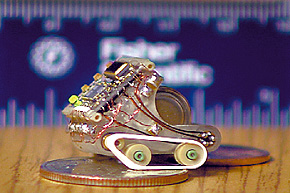
Here are two items that are pretty cool in and of themselves, but when put together show that we are developing the enabling technologies for microbot swarms like those depicted in Science Fiction from Star Trek to Cyberchild.
First you need tiny ‘bots:
The world’s smallest robotic hand, which can make a fist that can grasp objects smaller than a millimeter across, has been developed by Yen-Wen Lu and Chang-Jin(CJ) Kim of UCLA’s Mechanical and Aerospace Engineering Department .
The microhand hand has four fingers built of miniscule silicon segments and polymer-balloon joints, giving the hand a firm but gentle grip that the researchers claim would be ideal for manipulating tiny, delicate objects. In fact, in a (somewhat creepy) video on CJ Kim’s website, they show a close-up of the microhand delicately plucking what appears to be a single fish egg from a glob of roe.
Then you get them to work together:
A “swarm” of simple-minded robots that teams up to move an object too heavy for them to manage individually has been demonstrated by robotics researchers.
The robots cannot communicate and must act only on what they can see around them. They follow simple rules to fulfil their task – mimicking the way insects work together in a swarm.
The robots were developed by Marco Dorigo at the Free University of Brussels, Belgium, along with colleagues at the Institute of Cognitive Science and Technology in Italy and the Autonomous Systems Laboratory and Dalle Molle Institute for the Study of Artificial Intelligence, both in Switzerland.
“In the future we might have robots that actively seek help from others when they come up a problem they can’t solve alone,” says Dorigo, “For example if a robot can’t climb an obstacle without tipping over it might go back and get others to climb over as a group.”
 I realize that nature already has phenomenal microbots that work together (ants), and we are still a long way from a swarm of autonomous microbots, but these developments, coupled with micromachining and nano-self-assembly, empowered by “smart dust” networking, will eventually bring such devices about.
I realize that nature already has phenomenal microbots that work together (ants), and we are still a long way from a swarm of autonomous microbots, but these developments, coupled with micromachining and nano-self-assembly, empowered by “smart dust” networking, will eventually bring such devices about.















Most relevant SF reference: Waldo, by RAH.
Second most relevant SF reference: The Hacker and the Ants, by Rudy Rucker.
Rucker is my favorite living SF author.
Uh, what’s “smart dust” ? Anyone ? I suppose I missed this somewhere but, I’m always willing to learn something new.
Smart dust is the term given to groups of small devices that work together in a wireless computing network. Each device contains a little computer and wireless transceiver, and acts as a node in a larger wireless computing network made up of all the other devices around it.
Here’s a link to a good description with examples.
Wowser..been around that long huh ? Wonder how the folks are doing now ? Gives me a headache trying to encompass all the implications ! Thank You for the info.
#2, DeLeMa: It must be the stuff under my bed. No matter what I do it keeps coming back and forming gangs.
And then when hackers learn that these nanobots of the future operate on 60 year old nanotechnology, society will be held hostage by would be terrorists threatening to unleash the world’s greatest nano-plague..Great going, guys. Way to use that grant money.
One would think phds are curing cancer or something…Instead, they are having fun with tiny gobots.
uh…Instead of 60 year old nanotechnology, I meant to say 60 year old infrared technology…the nanites in my head made me do it !
Most work on RF tech, not IR.